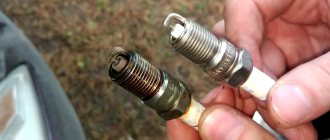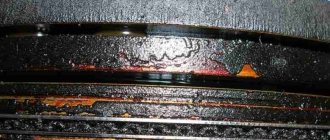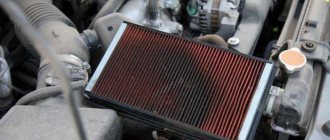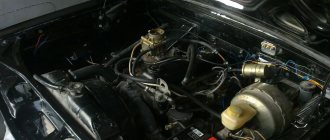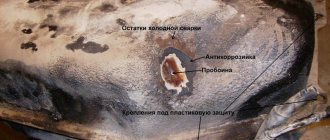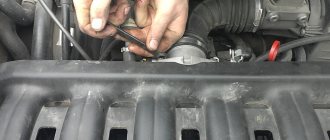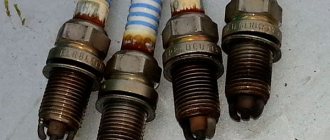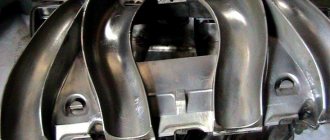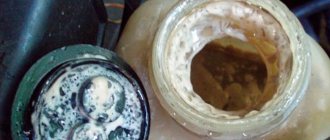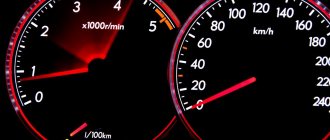In a car, all components and mechanisms must work correctly; this is how it will be a joy to operate the car. If minor faults are detected and corrected in a timely manner, you can avoid costly repairs in the future. Also, this approach to maintenance is the key to safe use of the car. It often happens that oil appears in the intake manifold. Let's figure out why this happens, how to diagnose and then fix this malfunction.
Why does oil get into the air filter?
There are frequent cases when, while replacing the air filter, the driver detects traces of engine oil on it.
Sometimes, this is detected due to signs of improper functioning of the air filter, the service life of which has not yet expired. If you find that oil is leaking onto the filter element, it is highly not recommended to continue using it, as this can lead to car engine malfunction. But, after installing a new air filter, the problem will not disappear, since after some time marks will also appear on it. Therefore, it is necessary to eliminate the cause of the appearance of engine oil.
Among the most common reasons why oil flows into the air filter are:
- If there is a malfunction in the engine, or its partial wear, gases that carry particles of engine oil can enter the air filter, and engine gases settle on it;
- Faulty piston rings. In this case, in addition to the air filter, oil enters the crankcase, as well as into the ventilation duct;
- Clogged hose that is used to supply oil;
- Malfunction of the pipe, as a result of which the oil mixes with gases;
- Clogging of the air filter itself, due to which the units do not receive the required amount of incoming air due to which the engine “chokes”, as a result of which it compensates for its lack from various sources;
- Severe wear of the oil seals, resulting in increased engine oil consumption;
- Excessive pressure of crankcase gases.
Tips and tricks
Considering that the formation of soot and the accumulation of dirt in the intake is inevitable, it is advisable to clean the intake tract for preventative purposes, and not when problems are already making themselves felt.
In cases where the diesel engine is constantly operated in city driving mode, treatment must be carried out every 6 months. This approach allows the engine to maintain its performance and avoid more serious problems. If the car constantly drives on the highway, that is, operating conditions are more gentle, it is recommended to clean the diesel engine intake at least once a year.
Compliance with these rules allows, by regularly treating the engine with an active chemical cleaner, to avoid the urgent need to disassemble the diesel engine for mechanical cleaning. At the same time, the risk of failure of expensive components and systems of a high-tech turbodiesel engine is reduced.
Finally, I would like to note that you should entrust the work of cleaning the engine and its intake tract only to qualified specialists, and also use exclusively proven original compositions from well-known manufacturers for cleaning. The same can be said for equipment.
It is important to understand that if everything is done correctly, then regular preventative cleaning of the intake allows you to solve existing problems and prevent the occurrence of new problems. Note that the cost of cleaning the intake tract of a diesel engine is quite acceptable, especially against the backdrop of costly repairs, which involve disassembling the internal combustion engine and replacing failed elements
Signs that oil is getting into the intake manifold
Before you say that there is oil in the intake manifold, you must be absolutely sure that this is the reason for the unstable operation. There are a number of signs that clearly indicate this defect:
- Unusual color of exhaust gases. When oil enters the intake manifold, the smoke from the pipe becomes black or bluish.
- When this defect occurs, the motor increasingly overheats. Moreover, it is not related to the load.
- Thrust drops greatly.
- Fuel and oil consumption increases significantly.
- The motor starts to run too noisy.
Common mistakes
When cleaning the damper, motorists often make the same mistakes.
It is important to remember what you cannot do in such a situation:
- at the first opportunity, when there are signs of unstable operation of the internal combustion engine, clean the damper;
- clean the unit without removing it from the car;
- use rough metal brushes and scrapers;
- do not adjust the speed after cleaning;
- remove molybdenum coating;
- make great efforts when cleaning.
Violating these rules can cause damage to the sensors and changes in the operation of the unit, which cannot be solved by simple cleaning. You will have to change components, which is quite expensive.
What is an intake manifold
Before eliminating the cause of oil getting into the intake manifold, you need to understand what this part is. This device is responsible for mixing the air flow with fuel. If clear proportions are observed, the engine runs like a clock. But as soon as the slightest inaccuracy arises, many problems arise.
When the pistons move in the device, a vacuum is formed. It allows you to achieve intrasystem pressure, which is lower than atmospheric pressure. Naturally, vacuum plays the main role in this process. It is he who is the source of driving force. Thanks to it, auxiliary systems begin to function, which include:
- vacuum operated brake booster;
- a system that controls the amount of harmful emissions;
- a device that corrects the advance angle;
- crankcase ventilation;
- Cruise control.
- Unusual color of exhaust gases. When oil enters the intake manifold, the smoke from the pipe becomes black or bluish.
- When this defect occurs, the motor increasingly overheats. Moreover, it is not related to the load.
- Thrust drops greatly.
- Fuel and oil consumption increases significantly.
- The motor starts to run too noisy.
Of course, this list is far from complete, since much depends on the car make and model.
Signs that oil is getting into the intake manifold
Before you say that there is oil in the intake manifold, you must be absolutely sure that this is the reason for the unstable operation. There are a number of signs that clearly indicate this defect:
More about Aveo: Stabilizer strut for CHEVROLET AVEO hatchback (T250, T255) 1.2 2008 price terms buy analogs characteristics - Avtopiter
If during operation you detect any of these signs, then you need to check whether oil is getting into the intake manifold. Only after a more detailed diagnosis will you be able to confidently say what’s wrong.
The tasks of the damper and its types
The throttle valve is a component of the fuel system.
The damper takes part in the formation of the air-fuel mixture, regulating the air supply to the engine intake manifold.
This is an important component of any motor. On one side, the element is connected to the air filter, since the air for the engine requires pre-cleaning. The other side of the damper connects directly to the manifold. When the driver presses the gas, the damper opens and a certain volume of air passes through it. The harder the pedal is pressed, the more air passes through the damper. This allows you to create a mixture of fuel and air, and then participate in the process of combustion and energy generation, which is converted into the movement of the car.
There are 2 types of dampers:
- Mechanical. They are used on old as well as budget cars. Checking the condition of a mechanical throttle valve is easy. It can be easily removed and cleaned with your own hands. In most cases, maintenance is carried out by car owners themselves.
- Electronic. Installed on more modern and expensive car models. It is not recommended to interfere with the design of the electronic damper without experience and skills. The main malfunctions are related to the fact that the settings are lost or the damper position sensor fails.
One of the common problems associated with this component is engine oil getting onto the valve. It is important to understand how this can happen, for what reason and what needs to be done to correct the situation.
Deformation of the cylinder head and its components
Another reason is a faulty cylinder head.
. In this case, some parts of this engine element simply do not fit together tightly, and as a result, oil passes into the manifold. This problem is often accompanied by a white coating in the oil and a decrease in engine power. Thus, it is simply impossible not to notice the malfunction.
There are several reasons for this phenomenon. First of all, the engine overheats. If the power unit is overheated for any reason, then the cylinder head is probably deformed. In this case, she suffers first of all. Therefore, you should operate the motor very carefully, avoiding overheating.
Cylinder head deformation can be determined visually or on a special stand. Carefully inspect the engine; if there is damage, you may notice a loose fit to the mating parts. But, sometimes the problem cannot be determined visually.
The main sign of deterioration of the guides is the knocking of valves
. Moreover, it is impossible to remove the problem by adjustment. Any of these malfunctions will require replacement of the cylinder head.
Ways to increase throttle life
At the manufacturing plant, even at the production stage, the throttle valve wells are coated with a special molybdenum coating. If not carefully cleaned or during use, it can wear out and become damaged. But this is not a death sentence - such coverage can be restored.
For these purposes, special materials based on molybdenum disulfide are used - antifriction solid lubricant coatings, which are produced both in liquid form and in aerosol packaging.
The MODENGY line of materials includes a special composition - MODENGY anti-friction solid lubricant coating for internal combustion engine parts. It is used to restore the factory coating on throttle valves, as well as to protect other engine elements: piston skirts, splines, plain bearings, threaded connections, etc.
This material is applied by spraying from an aerosol can from a distance of 15-20 cm. A distinctive feature of the coating is the ability to cure at room temperature. ATSP can be applied in several layers with intermediate drying for 20 minutes.
The coating kit includes the MODENGY Special Cleaner-Activator. This is a finishing agent that removes remaining contaminants from surfaces and ensures the best adhesion of ATSP to the base of the parts. This material can also be purchased separately from the coating.
Diagnostics
First, let's figure out how to detect oil getting into the manifold. In practice, there are several signs by which the problem can be identified. Knowing all these signs, you are guaranteed to be able to determine the presence of a malfunction:
Symptoms of a problem
This problem can be identified by certain signs. The oil may be directly in the intake manifold or in the throttle valve. This is the simplest diagnostic method, but it is associated with the need to disassemble the upper part of the power unit.
The problem is also identified by bluish smoke coming from the chimney. Even inexperienced drivers can see this. But this symptom may also indicate other problems with the engine.
You can talk about a malfunction if oil consumption increases sharply. It is worth checking its level regularly using the dipstick. When does oil still appear in the intake manifold? You can begin to suspect a malfunction if the engine thrust has noticeably dropped, and the noise level has increased during its operation.
Oil drops on the air filter are another sign. It's very easy to check if there is oil there. The air filter on most cars is very easy to access.
There are several causes of oil in the intake manifold. Let's look at the most common of them.
Cylinder head diagnostics
Deformations can be detected using special stands or visually. It is recommended to carefully inspect the motor for damage. If there are problems, then a loose fit of the parts to each other will be noticeable. But in most cases, visual diagnosis can be difficult. Then it’s a direct road to a specialized stand.
The wear in the valve guides can be determined by the knocking of the valves that accompanies engine operation. By eliminating these causes, you can solve the problem of oil in the intake manifold.
The intake manifold is secured to the power unit using gaskets. This avoids possible air leaks. The gasket also helps limit oil from entering the manifold. But over time it can become damaged. In this case, the oil still gets there.
There can be many reasons for its damage. Most often, these elements fail due to wear and tear. Sometimes the gasket breaks due to overheating. However, modern elements can withstand high-temperature influences. Sometimes the gasket is damaged during engine assembly.
In this case, getting rid of oil in the intake manifold is simple - you just need to replace the gasket. Then the collector is installed back. But you need to observe some nuances. It is recommended to thoroughly clean the surfaces of the engine and manifold. The nuts are pulled with a strictly defined torque.
Before we talk about why the turbine drives oil into the intake manifold, it is necessary to remember its structure.
To put it exaggeratedly, the compressor has a primitive design. It consists of a shaft on which two combs with blades are installed. One of the combs is driven by exhaust gases. The other rotates due to the fact that it is on the same shaft.
More about Aveo: Buy fuel tanks for Chevrolet Aveo T250 in Moscow - prices, photos, OEM parts numbers | FarPost
The number of revolutions can be high, so the shaft must be equipped with high-quality bearings. But as practice shows, dry bearings are not able to withstand work in a turbine. The part becomes very hot, as a result the unit overheats and jams.
For the unit to work effectively, it was necessary to somehow remove excess temperature and improve sliding. Oil does this very well. There are two lubrication channels connected to the shaft for each bearing. This way you can get high speeds and high performance.
Everything is fine, but this design provoked the emergence of many problems that cannot be solved today. And the most difficult of them is related to the fact that the turbine throws oil into the intake manifold.
Gasket problem
The manifold is attached to the engine through a gasket; it prevents air leaks and also limits the manifold from oil getting into it. But, this element can become damaged during operation, in which case lubricant gets into the manifold, and the motor also begins to malfunction. If there is a mass air flow sensor, the control unit will throw an error. These are all signs of damage to the gasket under the manifold.
note
that there may be several reasons for the occurrence of such a malfunction. Most often, the gasket is damaged due to prolonged wear. In some cases this happens due to overheating, but in general the gaskets that are used here are quite resistant to elevated temperatures. Sometimes this insulating element is damaged when assembling the motor.
The repair in this case is quite simple. It is necessary to remove the manifold and install a new gasket. Next we put the manifold back. Pay attention to a couple of nuances. The contacting surfaces of the commutator and the motor should be thoroughly cleaned, and after assembly the nuts should be tightened with a certain torque.
conclusions
. It is worth noting that there can be various reasons for oil getting into the intake manifold. Therefore, it is necessary to know all possible options and diagnose the problem by elimination.
Air filter dirty
Complicated air intake for the turbine is one of the causes of the malfunction. The air filter is often to blame for this - people forget to change it. The air intake pipes may also be partially blocked. It may get pinched or break.
During turbine operation, a vacuum is generated. If there is not enough air, the pressure increases significantly, oil is drawn out of the turbocharger.
View gallery
For a turbine, the air filter is very important. Basically, the lubricant is driven away due to the fact that the pressure is broken precisely because of the clogged filter. On turbocharged engines, the cleaning element must be changed every 8 thousand kilometers.
Pipes
This is another reason. If the oil has not been changed for a long time, the pipes tend to become clogged. Even if the turbine is repaired, the pipes are cleaned. It is very important. If the oil is under the intake manifold, then a pressure difference occurs due to the pipes or filter. It is also important to monitor the tightness of the air elements; if the pipes have cracks or other signs of deformation, they should be replaced with new ones.
Otherwise there will be excessive air leaks. This is harmful for both turbocharged and naturally aspirated engines. The problem is further aggravated by the fact that unpurified, dirty air gets through these cracks, bypassing the filter. And the presence of dust in the cylinders of internal combustion engines leads to premature wear of the piston group.
Breather and filter contamination
Everyone knows that the engine has a crankcase ventilation system. It allows you to relieve excess pressure in the crankcase, removing excess gas. It is worth understanding the technical features of this structural element to make it clearer where the oil in the manifold comes from.
Excess gases come out through the engine breather, but they contain a suspension of oil droplets that are knocked out of the “bath” during crankshaft operation. To avoid problems, a special filter is built into the breather, which traps drops of lubricant and returns it to the crankcase.
But, over time, the filter becomes clogged, and then gases begin to flow past this filter. In this case, gases along with oil enter the air filter housing. If the quantity is small, there is nothing wrong with this, but if the problem worsens, the lubricant will leak into the manifold.
What to do in this case? In fact, this problem is quite serious. If you do not pay attention to it in a timely manner, this may result in the need for a major overhaul of the power unit. Therefore, be sure to troubleshoot the problem.
To do this you will need to change the breather
. On some car models, it is possible to replace only the engine ventilation system filter itself. After this, do not forget to change the air filter. After completing this task, the problem with lubrication in the manifold will be eliminated.
Crankcase ventilation
The crankcase ventilation system is designed to reduce pressure in the crankcase. Pressure is formed there due to exhaust gases entering during engine operation. To do this, the crankcase is connected through a pipe to a low pressure zone or a vacuum zone. In naturally aspirated internal combustion engines, this is precisely the intake manifold. If the engine is turbocharged, then the crankcase ventilation is connected to the inlet pipe on the turbocharger.
Any turbine has a line designed to drain oil. It connects to the engine lubrication system. Most often, this line is connected below the oil level in the crankcase. Therefore, when the pressure increases, the oil from the turbocharger cannot be removed normally. This problem may also be due to a clogged separator. This is one of the nodes in the ventilation system. The pipe may also be coked.
How to remove oil from the manifold?
Oil in the manifold is a consequence of component failures and must be removed. The collector must be cleaned. In general, you need to clean it periodically as part of prevention - this will extend its life.
We begin the procedure by placing the machine on a lift. We blow out the power unit with compressed air. It would be a good idea to clean the outside of the engine - this will prevent dust from getting inside the internal combustion engine. Usually the collector is secured with a powerful screw, since the mechanism must withstand large mechanical loads. The immediate place of attachment of the unit is the frame. Unscrew the screw.
Then remove the throttle valve. You will also have to remove all sensors and pipes. To disable the sensors, disconnect the chips. The tubes are usually secured with clamps. To disconnect the manifold from the engine, unscrew the mounting bolts.
We dismantle and disassemble the device. To separate the parts of the manifold, you will have to unscrew a few more bolts. Then we remove the gasket between the two halves - if it is not damaged, it can be used again.
We place both halves of the device in the washing solution and keep it in it for some time. Then we clean them with a brush. We blow the entire structure with strong air pressure (this will remove small particles). We treat the contact surfaces with sealant, then assemble the device.
More about Aveo: Buy levers, rods, stabilizers for Chevrolet Aveo in Rostov-on-Don, sale of levers, rods, stabilizers for Chevrolet Aveo - prices, descriptions and photos on the Avto.ru website.
If oil smudges are visible on the internal combustion engine, this is a sign of incorrect engine operation. It is advisable to eliminate the causes of leaks without delay. If your existing knowledge is not enough, it is better to contact a car service center for the help of professional technicians.
How to clean the damper
When cleaning the throttle valve, at the same time pay attention to the position sensor and idle air control. They help the car to move away stably and maintain the desired speed. These sensors also need to be cleaned.
The work is divided into several stages:
- dismantling;
- cleaning;
- reverse assembly.
During the cleaning process, you will need a cleaner, rags, brushes, a set of keys and other auxiliary tools.
Removing the damper
If your throttle valve in a car is covered in engine oil and the contamination is already quite strong, it will not be possible to clean the assembly without dismantling it.
It is not recommended to clean the damper without removing it from the car. The cleaning efficiency will be low, plus the cleaner may get on rubber seals and other parts of the engine compartment.
In most cases, a similar component removal algorithm is used:
- remove the air pipe that connects the throttle assembly and the air filter;
- unscrew the bolts securing the filter housing with the motor;
- the lower pipe is disconnected;
- old rubber seals are removed (it is better not to reuse them);
- the draft is removed from the mechanically controlled damper;
- the rod should be carefully lifted and moved to the side without applying much physical force;
- Next, remove the idle speed control and throttle position sensor by squeezing out the corresponding connectors;
- then the retaining brackets are removed and the damper is dismantled.
After removing the damper, be sure to cover the manifold opening with a napkin or clean rag to prevent dirt from getting inside.
After removal comes the cleaning stage.
Cleaning from contaminants
The idle air control valve is usually attached to the throttle body. It should be removed by unscrewing the mounting screws. There is a rubber ring under the connection. It is better to remove it and avoid contact with cleaner or gasoline. If the ring is worn out, it is better to replace it.
Use any cleaner that suits you. There are no strict requirements or restrictions here. But it is better to take as a basis the products of a well-known and trusted manufacturer.
Most cleaners are sold in aerosol form. Even regular carburetor cleaner will do. The so-called carb cleaners. The damper surfaces are treated with the product, then some time is given for the solvent and additives to react.
External cleaning is more of an aesthetic nature, since in any case, the outside of the part will quickly become dirty. Don't waste a lot of money and time on this. It’s better to clean the internal elements, the connection with the body, the well, the idle speed sensor rod, the supply channels, etc.
How to solve the problem permanently
In fact, despite the serious consequences associated with oil getting into the intake manifold, fixing the problem is quite simple. It is enough to install the sensor. This device will monitor the area between the filter and the turbocharger.
If you do not want to spend money on installing a sensor, you can simply follow the manufacturer’s recommendations and change the filter on a schedule. But it is worth making one important note. The rate of contamination depends on operating conditions and loads, so it is not always possible to rely on manufacturers’ manuals.
The intake manifold is an extremely important part. The presence of foreign substances in it leads to disruption of engine stability. Therefore, it is extremely important to monitor the condition of the turbocharger air filter and replace it on time.
Cleaning the intake tract of a diesel engine
As you can see, it is almost impossible to get rid of all the factors and causes that lead to intake contamination. It turns out that to solve the problem, the best way is to comprehensively clean the intake manifold and other intake elements.
You can go two ways:
- disassemble the intake and physically remove dirt and soot;
- use cleaning methods without disassembling the internal combustion engine;
Naturally, most drivers will choose the second method. So, to achieve the desired result, an intake tract cleaner for diesel engines is used, which is a specially designed product to combat oily deposits of dirt and soot.
The product is supplied to the inlet under pressure using a special installation with a compressor. This allows you to carry out all cleaning work without having to disassemble the motor and remove parts. In this case, it is possible to clean the intake manifold, remove deposits, remove soot and carbon deposits from the intake valves, etc.
Simply put, the device is connected to the intake system, then the engine is started and the engine is allowed to run for about 120 minutes. At the end of the cleaning procedure, the diesel engine begins to operate more stably, fuel consumption decreases, the power unit stops smoking, power returns, and throttle response appears.
How can you tell if there is oil in the manifold?
The working fluid in this unit may not be noticed, since this is a closed area. And yet there are signs of the presence of oil, and usually they are as follows:
- Traces of working fluid appear in the throttle valve or air filter.
- Plumes of bluish smoke with an unpleasant odor pour out of the exhaust.
- The engine begins to intensively “eat” oil. It can disappear in the collector. Therefore, you should always monitor the level of the working fluid.
- The power of the power unit decreases.
- Fuel consumption begins to break all imaginable records.
Reasons for excessive oil consumption
Valve seals are one of the reasons why the engine takes oil.
Oil seals installed on the valves of the gas distribution system often lead to excessive consumption of engine oil. For example, due to an unheated engine, the likelihood that the cap cuffs will harden increases, and the engine mileage increases several times. A hardened cap does not seal, allowing oil to flow freely under the guide bushing along the valve stem. Then the engine oil will escape with the exhaust gases or, worse, cover the spark plugs in the combustion chamber, which will lead to a velvety soot on the spark plugs and interruptions in engine operation.
Piston and piston rings
Poor exhaust gas removal
As a result of increased resistance in the exhaust system (damage or failure of the muffler can, contamination of the catalyst, etc.), the pressure in the “hot” turbine scroll increases, causing exhaust gases to enter the middle turbine housing. There, accordingly, the pressure also begins to increase, which leads to the release of oil from the turbocharger.
As you can see, the presence of any of these signs will lead to the fact that even a perfectly operating turbine will begin to throw out oil. First of all, if you find oil in the intake manifold or turbocharger, make sure that the crankcase ventilation system is working properly.
Why you need to clean the intake: diesel and frequent problems due to soot
Owners of cars with a diesel engine are well aware that any malfunctions and deviations in the operation of this type of internal combustion engine require immediate diagnosis and elimination. The fact is that even short-term operation of a diesel engine that has begun to bleed, smoke, etc. can soon lead to much more serious consequences.
Taking into account the fact that repairing a diesel engine is more difficult than a gasoline engine, and many spare parts are significantly more expensive, it becomes clear that during operation it is necessary to regularly check the injection pump and injectors, as well as carry out preventive diagnostics of other expensive elements (for example, a turbocharger).
However, even if certain malfunctions suddenly become noticeable (thrust is lost, speed jumps appear, black thick smoke comes out when changing the gas, etc.), such signs do not always indicate that complex and expensive repairs are necessarily necessary. In other words, the owner should not get upset right away, since the solution to the problem may turn out to be very simple.
The fact is that in many cases, the culprit of diesel engine malfunctions is banal dirt and deposits that accumulate in the intake tract. In this case, the diesel engine behaves as if the unit has reached critical wear.
- As for the reasons for intake contamination themselves, there are quite a lot of them. In the CIS, the culprit can usually be considered to be low quality diesel fuel, low cetane number, and the presence of additional impurities. As a result, all conditions are created for increased carbon formation and coking.
- Also, do not forget that to reduce exhaust toxicity, all modern diesel engines have an EGR system, that is, there is a special EGR valve in the intake manifold, which allows for exhaust gas recirculation.
In short, when the engine is running under light load, this valve allows some of the exhaust to enter the intake and mix with the air that is supplied to the cylinders. As a percentage, about 15% of the exhaust gases make up a share of the total mass of the fuel-air charge.
Due to the fact that there is no oxygen in the exhaust added in this way, the combustion rate of the fuel-air mixture slows down, as a result of which the combustion temperature also decreases. This leads to a decrease in nitrogen oxides (NOx) in the exhaust gases.
In addition to environmental objectives, the recirculation system also reduces the risk of detonation in those modes when the diesel engine operates at extremely lean mixtures. The USR system is turned off (the valve for supplying the exhaust to the intake is closed) occurs when the engine is under high or constant loads, that is, an exclusively “rich” power mixture is needed.
In practice, the engine does not operate often in such modes, especially in the urban cycle. It turns out that the constant supply of exhaust to the intake occurs very often and leads to the fact that a lot of soot settles in the intake manifold, which accumulates on the walls. Thus, contamination of the intake tract in a diesel engine is inevitable and the owner needs to be prepared for this.
Let us also add that the breather of the crankcase ventilation system, which also discharges excess crankcase gases into the intake, is also involved in additional contamination of the intake manifold. As you know, there is oil mist in the crankcase, and oil traps are not completely capable of retaining all lubricant particles.
It turns out that not just soot accumulates in the intake, but oily dirt, which actively contaminates all surfaces and the EGR exhaust gas recirculation valve itself.
It is important to understand that if the valve begins to “hang” or jam, exhaust gases can be constantly supplied to the intake manifold, that is, this will happen in all modes. Naturally, in such a situation one should not expect traction from the engine, but acceleration dynamics from a diesel car.
Let's move on. Having highlighted the USR system and crankcase ventilation among the common causes of contamination of the intake tract of a diesel engine, it is also worth adding faulty glow plugs. The fact is that if the spark plugs do not work correctly, then starting a cold diesel engine becomes very difficult. Diesel fuel begins to enter the intake manifold, which further pollutes the intake.
Taking into account the above, it becomes quite obvious that over time the intake manifold becomes covered with a dense oily layer of dirt, as a result of which the diesel engine begins to operate unstably, loses power, produces smoky exhaust, etc.
Turbine
Another reason is a turbine malfunction. This structural element constantly circulates oil, which performs the function of lubrication and cooling. The turbine is located near the manifold, its task is to pump additional air, and it is due to this that it is possible to achieve an increase in engine power.
If there are problems with gaskets and seals, oil begins to enter the manifold during turbine operation. Moreover, this happens actively; there is quite a lot of oil. As a result, lubricant begins to spill through the top of the manifold. Actually, this malfunction manifests itself quite clearly.
You can see how the oil is driven through the manifold, and the lubricant also appears on the spark plugs. Having seen this, you can safely remove and repair the turbine. Also, in the presence of such a malfunction, you may notice some dips when gaining speed, this affects the poor performance of the turbine.
Repair in this case will have its own characteristics depending on the car model. For some car models you can find repair kits for turbines. This will allow you to avoid unnecessary costs and quickly repair the unit; you can do this work, including yourself.
An article on the topic “Which is better - a turbine or a compressor?”
How to check the PCV valve
After washing, you can check the general condition of the valve. At the slightest suspicion of a malfunction, it is better to replace the valve.
Checking the crankcase ventilation valve:
- shake the valve - you should feel and hear the valve elements dangling - this means the valve system is in a free position and is not jammed
- blow into the back of the valve (where the thread is) - air should flow freely
- blow hard into the fitting - no air should pass through
- suck in air from the side of the fitting, creating a vacuum of up to 30 kPa. If you are able to do this, the valve should almost close. But if you are not a superman, but an ordinary person, then connect its tube to the valve, but do not screw in the valve. Start the engine and let it idle - the valve should close. At the same time, you can “turn off the gas” and watch the operation of the valve. When the speed increases, the rod should return to its original position, and when idling, it should go deeper inward. Also, when idling, you need to lightly close the hole with your finger. The rod should return to its original position. A characteristic clicking sound should also be heard. I filmed this process to make it clearer
I carry out this procedure every time I clean the throttle assembly.
Pros and cons of a closed crankcase ventilation system
In the end, I would like to compare the advantages and disadvantages of the crankcase ventilation system for those who want to get rid of it.
Disadvantages of the crankcase ventilation system:
- oiling of the engine intake tract - regular cleaning is required
- if the engine is in poor condition, the volume of crankcase gases is so large that you can forget about the normal operation of the system and the engine - engine repair is required
Advantages of the crankcase ventilation system:
- our air is cleaner, since crankcase gases are much more toxic than exhaust gases
- less chance of seeing leaks through seals and seals
- engine oil life increases
- oxidative processes inside the engine are reduced
- crankcase gases increase knock resistance
- the crankcase does not communicate with the atmosphere, as a result of which dust and moisture are not sucked into it
Okay, I’ll write something else
What happens if you turn off the crankcase ventilation system?
This is a true story.
Once upon a time there lived a good guy and he had a VAZ 2106. Like most drivers, he disconnected the crankcase ventilation hose from the filter on the carburetor and left it hanging around under the hood. Everything was the same as everyone else’s - he drove around, smoked slowly, didn’t bother anyone.
Then a seemingly normal idea came to his mind - to civilize the whole thing so that it wouldn’t smoke under the hood and wouldn’t suck this crap into the cabin. He took a longer hose and ran it under the bottom to the area of the driveshaft outboard bearing. I tied everything up well and started smoking again slowly.
Winter has come. In the evening, after work, everyone gets into their own cars and gets ready to go home. He started the engine and waited for me to drive away to clear the way.
In my thoughts I poke the key into the lock, turn on the ignition and then there is a terrible explosion! I was frightened and didn’t even understand what was happening. I jumped out of the car, I saw that my partner’s eyes were like five kopecks, he was all afraid, and there was smoke coming from under the hood.
We open the hood, and there... May God have mercy... Everything is covered in oil, the dipstick is not in place, its ventilation hose has been torn off. Wiring, engine, hood - everything is leaking oil! Horrible, in general...
We looked under the car, and there was a big, big icicle hanging from its ventilation hose. Here everything became clear. This hose was long and tied in several places. Not only did it go in “waves”, it also went a little upward. Condensation constantly collected there and did not drain anywhere, and with the arrival of frost, it began to freeze until it completely shut down the crankcase ventilation.
That's it.
Now, in principle, that’s all I wanted to write about about the crankcase ventilation system.
Well, and a video about the crankcase ventilation system
Peace and smooth roads to everyone!!!
More in the My Lacetti community:
+5
